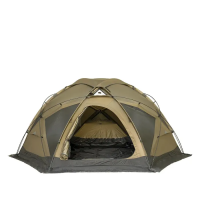Cart
Avoiding Common Mistakes When Using and Caring for Your Tent Footprint
Introduction:
A tent footprint is a protective layer that goes underneath your tent to provide an extra barrier between the ground and your tent floor. It helps prevent wear and tear, adds an extra layer of insulation, and keeps moisture from seeping into your tent. While tent footprints can greatly extend the lifespan of your tent, many campers make common mistakes when using and caring for them. In this comprehensive guide, we will discuss the importance of tent footprints, common mistakes to avoid, and essential tips for proper use and maintenance. By following these guidelines, you can ensure your tent footprint serves its purpose effectively, prolonging the life of your tent and enhancing your camping experience.
Section 1: The Importance of a Tent Footprint
1.1 Protecting Your Tent
1.2 Insulation and Moisture Prevention
A tent footprint adds an extra layer of insulation between your tent and the ground, helping to regulate temperature inside the tent. It also prevents moisture from seeping through the tent floor, keeping you dry and comfortable during wet conditions.
Section 2: Common Mistakes to Avoid
2.1 Incorrect Sizing
2.2 Poor Site Selection
2.3 Improper Positioning
2.4 Neglecting Cleaning and Maintenance
Many campers overlook the importance of cleaning and maintaining their tent footprints. Leaving dirt, debris, or moisture on the footprint can lead to mold, mildew, and deterioration. Regularly clean the footprint after each camping trip, allow it to dry completely before storage, and store it in a dry, ventilated area to prevent damage.
Section 3: Essential Tips for Proper Use and Maintenance
3.1 Seam Sealing
3.2 Proper Storage
3.3 Regular Inspections
Before each camping trip, inspect your tent footprint for any signs of damage, such as tears, holes, or weakened areas. Address these issues promptly by patching or replacing the footprint if necessary. Regular inspections will ensure the continued effectiveness of the footprint in protecting your tent.
Conclusion:
- Contact Us
-

About Pomoly
Pomoly is a leading camping brand specializing in hot tents and tent stoves. We are camping life explorer, Follow Page / Join Group, let's make camping enjoyful together!
Working Hours
Mon-Fri, 09:00 - 17:00

- Company Info
- NEWS
- About us
- Pomoly Name
- Leave-No-Trace
- Contact Now
- Facebook Group
- YouTube Learning
- Product News
- Contact Us
- Topic Collections
- Policies & Terms
- Payment Policy
- Shipping Policy
- Return & Refund
- Privacy Policy
- Terms of Use
- Tax Policy
- Website Disclaimer
- Safety Disclaimer
- Warranty Policy
- Promotion Policy
- Pre-order Policy
- INTELLECTUAL PROPERTY RIGHTS
- Dealers Agreement And Terms
- Become Affiliate
- User Center
- Forget Password
- My Orders
- Tracking Order
- My Account
- Register
- Popular Searches
-
Tipi Tents Dome Tents Camping Tent Hammock Stove Camping Camping Pellet Stove Circle 6 Titanium Water TankDome X Locomotive 20 LEO 2 camping tent T-Brick 2.0 T1 2.0 tent stove Dweller wood stove Oroqen 2.0 Chimney Water Tank Lumberjack STOVEHUT Bromance 70 Tipi Pomoly Coupon Baker Oven Stove Titanium elbow Fire Pits Tent Stove titanium Stove Outdoor Pellet Stove
keebon pellet stove






